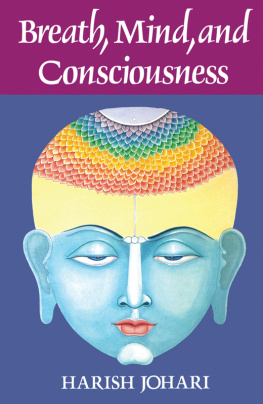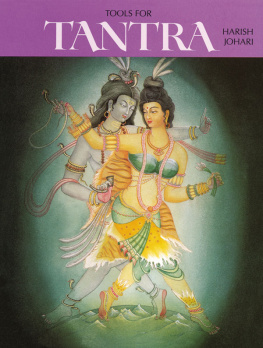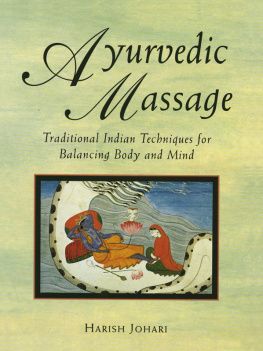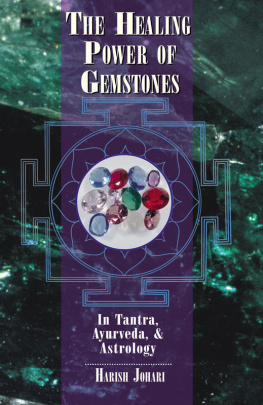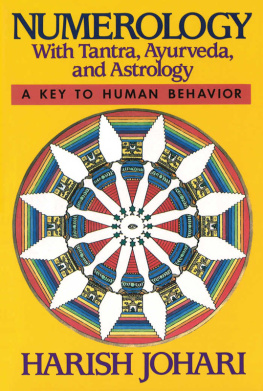OTHER TITLES BY HARISH JOHARI:
Ayurvedic Massage
Charkras
Chakras (Spanish Edition)
The Healing Cuisine
The Healing Power of Gemstones
Leela: The Game of Self-Knowledge
Numerologa
Numerology
Tools for Tantra
AUDIOCASSETTES BY HARISH JOHARI:
Attunements for Dawn and Dusk
Chants to the Sun and Moon
Sounds of Tantra
Sounds of the Chakras

Breath, Mind, and Consciousness

HARISH JOHARI

ACKNOWLEDGMENTS
I AM INDEBTED to Baba Kailash Giri of Chaudhry Talab Temple, Bareilly, for introducing me to the wisdom of Swara Yoga. I thank Baba Santosh Dass and Baba Dwarika Dass, whose company gave me a clearer perspective on this science. Without good companysatsangtrue understanding is impossible; it brings positive feedback, impetus, and the inspiration required to make progress in any branch of learning. Shyam Lai, the cobbler, Pandey Jo, Premji, and all my friends who practice Swara Yoga deserve thanks. In their company I was able to verify my tests of Swara Yoga while in India during 1965 and 1966.
As well I am grateful to Dr. Philip Epstein who helped me understand the relationship of Swara Yoga to neuro-biology and neurochemistry. Dr. James Daley deserves special appreciation for introducing me to the Western vision of this yogic science. He was kind enough to provide me with a brain wave analyzer during my research in Oakland in 1972. I would also like to thank Dr. Shannahoff-Khalsa for his contribution to better mental health through an understanding of the relationship between the nostrils and the hemispheres of the brain.
Finally, I thank all my friends and students who have applied the knowledge of Swara Yoga and have made use of the Prana Calendar since I published the first edition in 1974. Carmen Carrero and Heidi Rauhut also deserve thanks for preparing the typed manuscript from my hand-written pages.
HARISH JOHARI
Uttar Pradesh
March, 1989
INTRODUCTION
B REATH IS the physical counterpart of the mind. The mind uses the cerebral cortex of the brain, the twin hemispheres, as its tool. These two hemispheres coordinate with the entire organism through neuromotor responses. All neuromotor activities, all sensory and motor functions of the body, are performed with the help of the breath. So breath is mind in action! Breath provides the pranic force to the organism. This pranic force, working as the Air element, creates movement, pulsation, vibration, and life. The word spirit comes from the Latin word spiritus, which literally means breath.
Mind and consciousness are abstract termswhereas breath is a physiological reality. The study of consciousness begins with the study of the true science of breathing. Breath induces movement. Breathing itself is a neuromotor activity. The science of controlling prana is known as pranayama, a branch of Hatha Yoga. The term Yoga, which literally means union, refers to a discipline, a way of evolving the higher faculties of mind. There are many paths in Yoga, but in essence they all have one goalthe union of the self with God. On the physical level, this means the union of the lower brain with the upper brain. Mans faculties of abstract thinking and his aspirations for the higher ideals of life (seated in the cerebral cortex) often conflict with his instinctive, animal nature (seated in the lower brain). Through Yoga, man can learn to master his lower brain and pursue higher ideals, to act in accord with the law of universal good. While his animalistic nature makes man hedonistic and selfish, yogic training makes him selfless.
All yogic disciplines clearly state that a direct relationship exists between prana and mind and that by controlling or mastering prana one can master the mind. According to Yoga Kundalyupanishad, the breathing process creates images in the mind; by controlling the breathing process through pranayama, the breath becomes calm, images do not disturb the mind, and the internal dialogue stops. According to Dr. David Shannahoff-Khalsa of the Salk Institute for Biological Studies in San Diego, The nose is an instrument for altering cortical activity (See .) Stop the prana and mental modifications will stop, and the yogi will be able to establish himself in bliss (samadhi). Prana refers not only to the flow of oxygen into the organism but to all components of life force. Prana is the vital life force that sustains all living organisms. Pranic energy is available in negative ions, oxygen, ozone, and solar radiation, but for human beings its main source is the breath.
Swara Yoga is the science of nasal breath. It has rightly been called the ancient technology of mind. Not a part of Hatha Yoga or other yogas, the science of Swara Yoga deals with the relationship between the nasal breath and the subtle nerves of the body, on the one hand, and the cycles of the Moon and the elements, on the other. It studies the nasal cyclesthe nature of the breath flowing with the right and left nostrils. The teachings of Swara Yoga allow us to synchronize our breath, our life, with the universal rhythm of the Moon. This alignment removes the effort and strain from our daily activities and brings good fortune.
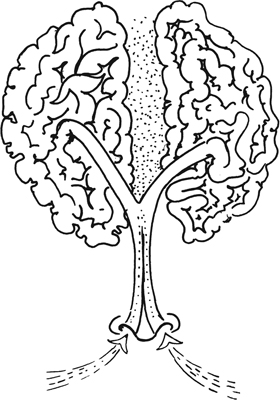
FIGURE 1. Posterior view of the hemispheres of the brain and their relationship to the respiratory system. Breath coming in through the right nostril cools the right hemisphere of the brain, causing the left hemisphere to become active. Breath coming in through the left nostril has the opposite
The founders of Swara Yoga were not familiar with the cerebral hemispheres, but they did work with the principle of bipolarity: the right side of the body being the masculine, solar principle, or Shiva, and the left being the feminine, lunar principle, or Shakti. Reaching into the depths of human behavior, they were able to ascertain which activities were best suited for right nasal dominance, and which for left. By observing the direct effect of the moon on the breath, they discovered the sacred science of right living. This book offers methods for determining right/left nostril dominance and for synchronizing the dominant nostril with specific activities of everyday life.
The implication of this technology is that we are not helpless victims of a given emotional state. If you want to alter an unwanted state, says Dr. Shannahoff-Khalsa, just breathe through the more congested nostril. By altering the flow of nasal breath, the body chemistry gradually changes, and unwanted emotional and physiological states slowly disappear.
Swara Yoga can teach human beings the precise way of living peacefully, as masters of their own mind and body; it can enable them to become true instruments of Consciousness. This book gives the reader a key for self-tuning the body/mind with the body/mind itself as the tuning instrument.
CHAPTER 1
The Science of Swara Yoga
O UR HUMAN ORGANISM works through a specialized network of channels known to physical science as nerves, veins, and arteries. Those conduits that enable us to act and react to our environment are known as nerves. We will use the term nodi to refer to the subtle nerves of the body. The autonomic nervous system runs the inner machinery of the organism via the sympathic and parasympathetic branches. All nerves and nadis form a network around each cell, fiber, tissue, bone, etc., to keep the organism conscious of its environment and itself. As long as the flow of energy in each nadi and nerve is working in proper rhythmic order in a particular area, life exists. When the nadis are blocked, the organ connected with them becomes lifeless, and as a result the organism develops many diseases.
Next page
